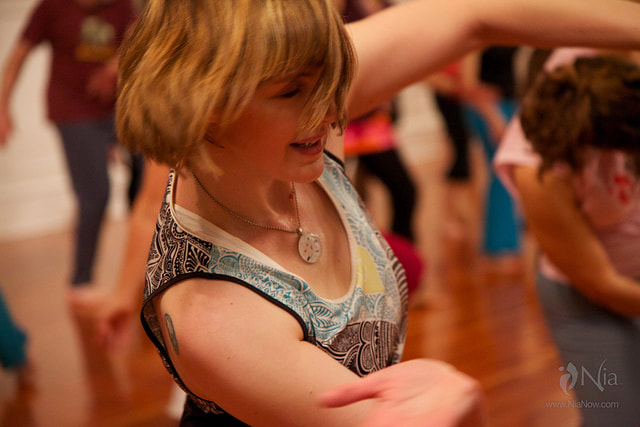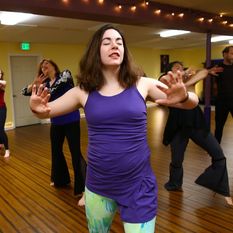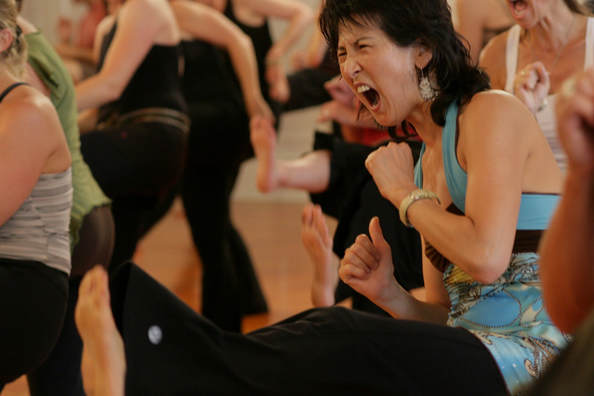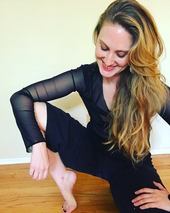|
By Emily Freebairn
Before Nia, dancing made me uncomfortable. I was awkward and vulnerable on the dance floor, and sure that no matter what I was doing it looked wrong somehow. There didn’t seem a point to purposely displaying myself for other people to make fun of. Fortunately for me, that’s not what dancing is. And Nia taught me that. The first time I went to a Nia class, I was bewildered. I didn’t know what the different moves were, and the language was funny and seemed too woo-woo. The floor was “ground”, and “earth”, and how on earth was I supposed to smell the moment? But even while my mind was picking holes and looking for reasons not to come back, my body was experiencing something new and treasured for the first time. I left that class feeling elated in a way I hadn’t in a long time - a buzz throughout my entire being that made me feel like I could do anything. I immediately knew I had to come back. At the same time, I had no previous frame of reference for this wild joy that left me skipping out of class. I’d heard “endorphins make you happy”, but I’d exercised before and hated it. I’d danced before and at best I’d been relieved no one had outwardly laughed at me. How was Nia so different? Before Nia, I thought of my body as a tool - something that did what I told it to do the same way every time. I didn’t listen to my body because exercising was painful. Nia’s concept of “Your Body’s Way” - the idea that my body was different from day to day - was a quiet revelation to me. It made me curious about my body. Instead of a tool, my body was fluid, changing moment to moment. A kick one day might feel fantastic; the next class my hip might be sore. Of course I needed to pay attention to my body - how else was I supposed to know what it could do? In Nia, there’s a give and take. Every time the teacher says “sense your ____” is an opportunity to check in with my body and sense where it wants to move, what parts are stuck and need some extra love. I learn to get out of my head and trust that my body’s experiences are valid. No judgement, no stories about how I’m getting older, my desk job is finally getting to me. Just acceptance, and a growing awareness of my body’s sensations. My body has a voice, and I need to listen to know what is needed. Nia helps remind me I’m not a floating brain case - living is a full body experience. During my White Belt, my trainer Jill Pagano called the body sacred, where sacred is defined as “being entirely devoted to something”. My body is sacred, because it exists solely for me. It is the filter through which I experience everything. My body knows things in a way my mind can’t articulate, and when I listen, and dance, I learn. Nia has helped me deepen my relationship with my body and broadened my experiences of body, emotion, and imagination. My body is an integral part of my life. I cherish the times I get to explore it and understand it more fully. By Melanie
One of the stories I love to tell people when they ask about Nia is that when I took my first class, I couldn’t turn. This surprised me. In Nia, we move through a turn based on the energy of Aikido, inviting in ease and stability in the base and coaxing forth mobility from the hip joints. If one is experiencing tightness through the hips - which can be common among people going through emotional difficulty - turning can be difficult. For me, in that introduction to Nia, it was impossible. It’s one of the reasons that, after class, I went home and had a cathartic ugly cry in my shower. It’s not the only reason, let’s be clear. My life at that time – this is a decade ago – might as well have been a broken glass bowl. Here’s what I mean by that: Imagine you’ve created this perfect vessel. It is symmetrical, elegant, shiny. You display it proudly in your hands. Onlookers admire it. And then a random event/object/elemental burst/whatever, you name it, hits you and knocks you off balance. The vessel you worked so very hard to create, to perfect, tumbles out of your hands and shatters at your feet. The sonic burst of its destruction rips the air with a high-pitched and cruelly clumsy “clang!” that may sing in your memory for months, for years. What do you do? Do you sweep it up and start over, as much as the loss may break your heart? I did not do that. Nope! I tried to piece my beautiful life back together just the way it was. I tried to reconstruct the impossibly devastated with inadequate tools, tried to remake the vessel out of its splinters with child-friendly paste and gum and fraying recycled thread. To borrow a line from one of my favorite TV series, I tried to make burnt toast bread again. That is a recipe for disappointment and frustration and depression. And, yes, anger. What does this have to do with Nia? Simple – that class provided the first tool in what became a growing box of them. I decided I wanted to turn, because I used to be able to dance. I saw other people turning. Why couldn't I? I signed up for more classes to find the answer which ultimately was, "Oh yeah - I can. I just needed to figure out how, again." This leads me to another story I tell people who ask me about Nia, and specifically whether they can do it. “I’d love to dance, but I can’t, is that a problem?” That's a popular one. (And no, it's not a problem. Nia is, in fact, terrific for people who think they can't dance.) Another is “I haven’t exercised in forever!” I understand. Neither had I, when I first came to the practice, when I couldn't turn. I was out of breath. I kept dancing. I felt better, stronger, more energetic. Positive, for once. Then I decided to take the White Belt Training and, wow. That gave me a whole new set of tools. I tell people, the fact that I teach Nia is evidence that anyone can do this. Nia is a tool for discovering a new relationship with our bodies, and with wellness. Not only that, it provides lessons in living and communicating better and turning into the next step of newness, into more than what was. I teach because I love sharing that joy and adventure, and I love being surprised and amazed and yes, at times befuddled and even frustrated, at the movement presented in new routines. I teach Nia and take classes from other Nia teachers because it is a sustainable practice, one that I know I can and will play with and learn from for the rest of my life. I can turn now. I love turning, which is one of the reasons I’m loving my return to the routine Birth this week. There’s a lot of turning in Birth, including turns in low plane that I couldn’t execute when I first taught it in a gym some years ago. There are also strengthening opportunities in FloorPlay that I can enjoy now that I couldn’t do a few years ago – again, as a teacher. I lacked the strength and the coordination back then. But I kept going. I persisted. Oh yes I did. It brings me joy to say that I am physically stronger now thanks to the lessons within this practice. Even more joyfully, I can say that I now know building upon that sensation is always possible. There is always opportunity to turn into more. In the process of connecting more deeply with Nia, I’ve constructed a new vessel that is my life. The vessel is not unbreakable; the impermanence of existence makes that impossible. But it is malleable. It leaves room for change, a constant. It can take on different shapes. It has the capacity to grow larger, hold countless new ideas, to float through explorations of the realms of mind, body, emotion and spirit. We can all turn, in our own way. We all have these tools in our hands. What beautiful vessels will you create for yourself and your life? I can’t wait to see. Want to know more about Nia? Join us for our Intro to Nia class on Friday, September 21 at 6 p.m. Ready for a deeper dive into the practice? Sign up for a White Belt Intensive with trainer Britta Von Tagen. By Christina Kemp
|
Movement Meditations
Where our instructors share information and observations about what's going on at Move2Center Studio! Archives
April 2022
Categories |





 RSS Feed
RSS Feed